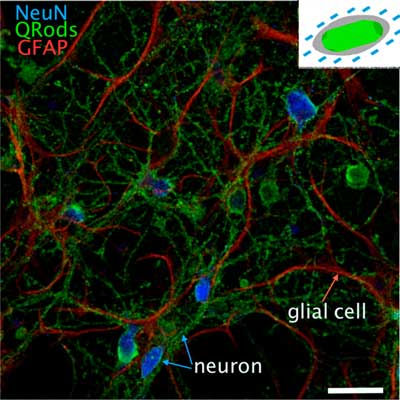| Posted: Jun 27, 2017 | |
Targeting neurons with nanoparticles(Nanowerk News) A research team in Italy has elucidated the mechanisms through which nanoparticles modulate bioelectric activity from single neuron to neuronal networks. |
|
| The use of nanoparticles as drug carriers or therapeutic materials for brain diseases requires a deeper understanding of the principles governing their interaction and functional effects in neuronal circuits. | |
| Given the increasing number of nanoparticles available and the increasing interest in studies pertaining to nanoparticle-cell interactions, there has been a substantial effort to correlate the nanoparticles material features (composition, size, shape, coatings, etc.) to their neuronal toxicity and activity. | |
| Reporting their work in ACS Nano ("Selective Targeting of Neurons with Inorganic Nanoparticles: Revealing the Crucial Role of Nanoparticle Surface Charge"), the scientists tested the effects of nanoparticles that differ in shape (spherical and cylindrical), dimensions (inorganic core material ranging from 5 to 75 nm), composition (cadmium- or iron-based), functionalization, and charge. | |
| By combining confocal microscopy and transmission electronic microscopy with single neuron and network-wide electrophysiology techniques on primary hippocampal neuronal cultures, the researchers found that soon after administration of the nanoparticles, the neuron-nanoparticle interactions are exclusively determined by the surface charge of the nanoparticles. | |
 |
|
| Negative nanoparticles interact exclusively with excitable neurons. Neurons labeled with NeuN (blue) and glial cells labeled with GFAP antibody (red) were treated with 1 nM negatively charged quantum rods (QR, green, -35 mV). Note the QRs attach exclusively to the membrane of neural cells. Scale bar: 50 µm; excitation wavelengths: 488, 560, and 647 nm. (© ACS) | |
| The team observed that negatively charged particles were selectively localized on the neuronal membrane and induced electrophysiological alterations at both single neuron and network levels. | |
| Further, results obtained through the pharmacological manipulation of the electrical neuronal activity suggest that the neuron-nanoparticle interaction is mediated by neuronal activity. | |
| The team's theoretical model explains how a Coulombic potential on the outer neuron surface retains only negative nanoparticles. Importantly, these simulations predict membrane depolarization that supports the experimental evidence of increased neuronal activity, as measured at the single neuron and at the whole network levels. | |
| However, this simulation model does not account for the selective interactions of nanoparticles with neurons and not with nonexcitable glial cells. Based on the scienists' data, three key factors appear to determine the selective localization of negatively charged nanoparticles on neurons and the electrophysiological activity change: | |
|
|
|
| In summary, the team found that nanoparticles with negatively charged surfaces rapidly localize on neuronal membranes and induce electrophysiological alterations. | |
| In contrast, the same type of nanoparticles with positive or neutral zeta-potential shows no or low nonspecific interaction with the cellular membrane and no effects on bioelectric activity. | |
| These effects are material independent because similar results occurred with magnetic nanoparticles as well as Cd-based semiconductors. | |
| Importantly, the interaction of negative nanoparticles is not only selective for excitable neuronal cells but also dependent on neuronal activity. | |
| "These observations suggest that electric activity most likely plays a role in the specificity of the nanoparticle-neuron interaction," the authors conclude. "Finally, numerical simulation supports the proposed mechanism for the selectivity of negative nanoparticles and the modulation of neural electric activity." |
 By
Michael
Berger
– Michael is author of three books by the Royal Society of Chemistry:
Nano-Society: Pushing the Boundaries of Technology,
Nanotechnology: The Future is Tiny, and
Nanoengineering: The Skills and Tools Making Technology Invisible
Copyright ©
Nanowerk LLC
By
Michael
Berger
– Michael is author of three books by the Royal Society of Chemistry:
Nano-Society: Pushing the Boundaries of Technology,
Nanotechnology: The Future is Tiny, and
Nanoengineering: The Skills and Tools Making Technology Invisible
Copyright ©
Nanowerk LLC
|
|
|
Subscribe to a free copy of one of our daily Nanowerk Newsletter Email Digests with a compilation of all of the day's news. |
